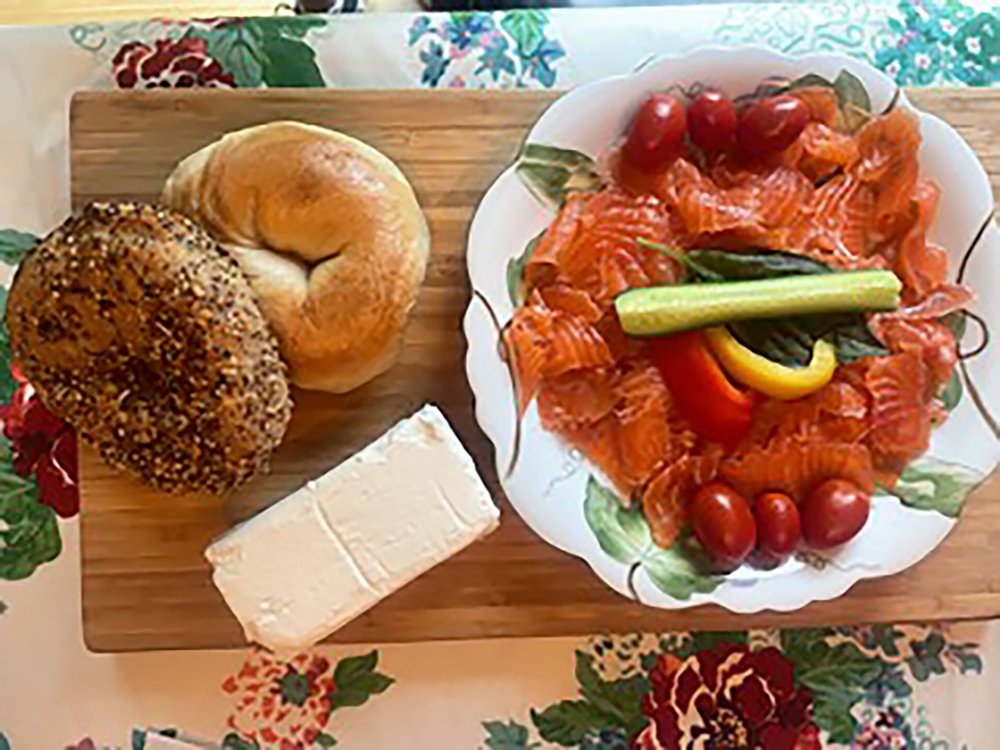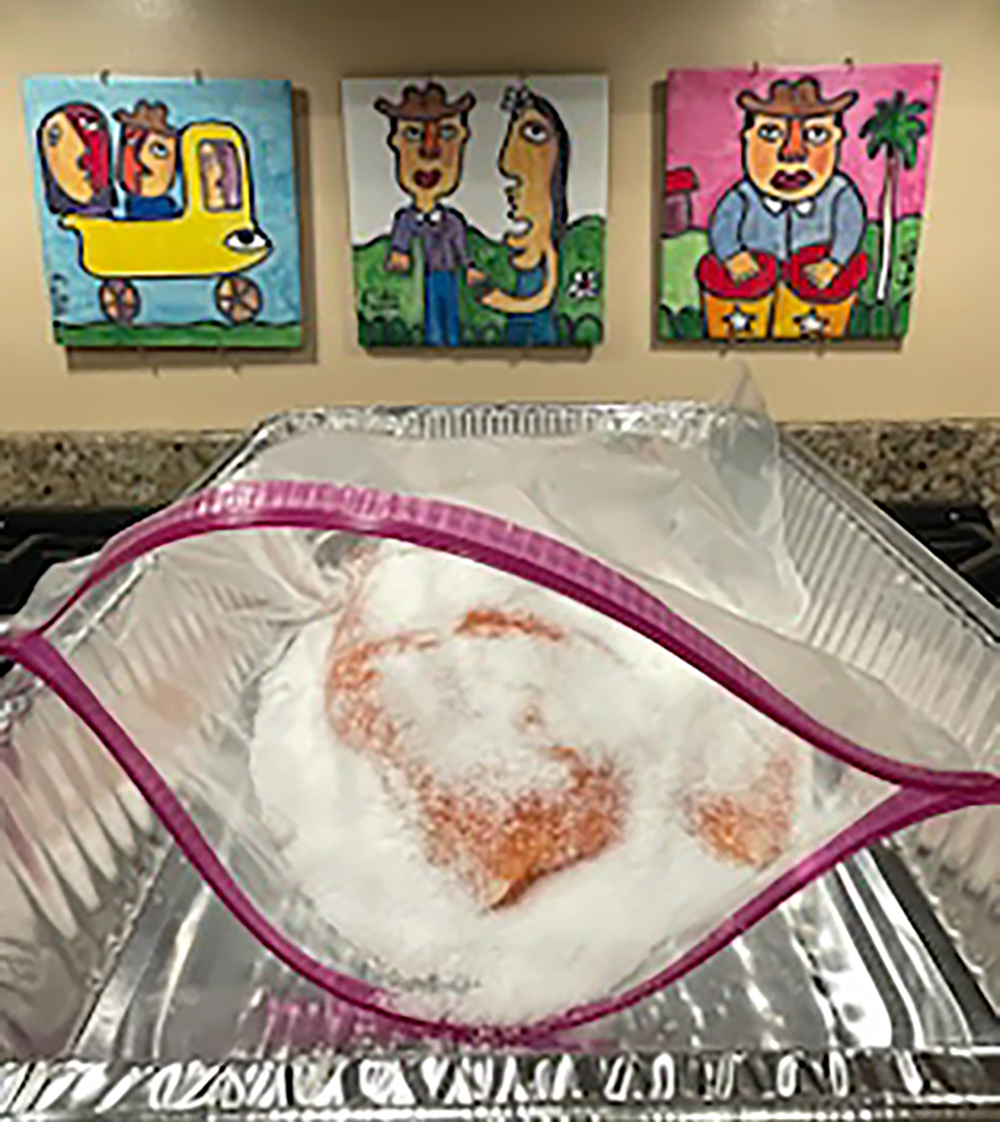Life is What Happens
By Lisa Zaslow Segelman
Bagels and lox. Lox and bagel. Bagel and gravlax. Bagel with a schmear. People affectionately refer to this breakfast/brunch meal in their own way.
In the Jewish culture, it’s a staple. It’s expected to be there when you get there and some part of its components pleases nearly everyone – the smallest children are happy with a buttered, creamcheesed, crust of plain bagel, and the lox and other fish selections most likely appeal to more mature palates.
My son calls it “the same old” as a lox ‘n fish meal often shows up at family gatherings, be it a Sunday brunch, a baby’s bris, or the morning after a wedding or bar/bat mitzvah weekend. It’s my go-to for hosting.
Saturday morning may be challah french toast leftover from the Jewish Sabbath on Friday night, but Sundays are traditionally some version of lox ‘n fish at our house.

Just to be safe, I often serve tuna and egg salad for guests who just don’t eat fish or appreciate the toothsomeness of lox.
The word “lox” comes from the Yiddish word for salmon, “laks.” Lox is a fillet or strip of brined salmon. Brining salmon is a solid Scandinavian tradition, but it was also popular among Eastern European Jews. During the wave of immigration in the early 1900s, Jewish immigrants brought their love for brined, cured and smoked fish with them. Brining is similar to curing, but less time intensive.
Lox is just one part of the meal. Its sister fish is smoked whitefish, kippered salmon, chub or sable which can be eaten whole and sliced or as a salad mixed with mayonnaise, celery, lemon juice and the like. Add in a platter of sliced tomato, onion and an array of cream cheese sand you will have yourself a brunch that will keep the compliments like, “nice spread” flowing. You can also do a lot of this plating the night before for a more relaxed morning.
Garnishing and presentation are important because just looking at a plate of orange lox is a little boring. Add in thinly sliced cucumber, black brined olives (try to skip the canned variety), lemon slices and a sprinkle of capers.
Some of these delicacies can be expensive. I buy Kirkland smoked salmon at Costco for $13.33 a pound to combat the usual $22-$24 cost. Although people use the terms lox and smoked salmon interchangeably, they’re not the same. Lox is just brined, not smoked. For cost efficiency over the supermarket, I also buy whitefish salad in a larger tub at BJ’s.
While Costco smoked salmon is fine, some people make their own gravlax, a cousin of lox, which is surprisingly easy to prepare. While both lox and gravlax are cured salmon, lox is saltier with a simple flavor profile, and gravlax is seasoned with salt, sugar, dill and even alcohol like aquavit.

Gravlax translates to “grave-salmon” – the word “grav” means grave and “lax,” as mentioned above, means salmon. The name refers to the medieval practice of curing the raw fish by burying it in the sand above the high tide level (thus the grave association) which today is achieved by curing Norwegian salmon fillets with salt, sugar and dill.
Absecon Island native Sue Weitz Paymer, who was Miss Ventnor 1966 at just 16 years old, is known around the island for making her own gravlax.
“I buy good quality salmon at local fish markets, which is still much more cost efficient than buying lox or gravlax already prepared,” said the former (and current) beauty queen, “and then I get to work.”
I interviewed Sue en route to dropping off the finished delicacy to her son, and grandson’s home in Margate.
“I’ve been making gravlax for about 20 years,” said Sue. “It’s really not as daunting as people imagine. Most weekends in the summer we have family and friends for brunch and they expect it to be on the menu. The same goes for our yearly family reunion. People request it in advance. My grandchildren love it, which makes me happy.”
You don’t have to be a beauty queen or have a big family to try making gravlax. Follow Miss Ventnor’s recipe and you may just develop your own gravlax family and friends following.
Susannah Weitz Paymer/Miss Ventnor 1966:
Gravlax Recipe
Note: Be sure to use 2 gallon-size plastic bags
Ingredients:
- 1 whole side of farm-raised salmon or at least 2-pound fillet:
- (Ask fishmonger to remove the skin. Randall’s Fish Market and ShopRite will do this for you)
- 1 whole side
- 1 cup sugar
- 3 cups kosher salt
- 1 large bunch fresh dill
- dry dill
- 3 T tequila
- 2 T vegetable oil
- liquid smoke
Method:
Combine 1 cup sugar and 3 cups kosher salt, and place half of that in the bag. Layer the fresh dill and then some dry dill.
Place salmon over that (skin side down if not removing the skin). Add more dry dill and remaining salt/sugar mix and spread evenly over fish. Sprinkle with 3 T. tequila.
Carefully close airtight, place in a shallow pan and put heavy weights or bricks on top. The heavier the better. Allow to cure in the fridge for 30 hours.
Next Day:
Remove salmon, rinse quickly and thoroughly in cold water. All salt and sugar should come off. Pat thoroughly dry with paper towels after rinsing. Throw away all salt/sugar and dill. Mix 2 T. vegetable oil with 1 T. of liquid smoke. You can use light surgical gloves (order on Amazon or buy at drugstore) to rub the mixture on the palms of your hand and massage onto both sides of the fish.
Place in a fresh, large bag. Zip airtight and put the salmon back in the fridge to cure some more. Take out the next morning. Remove the fish and lay on a flat cutting board. Slice very thin on the diagonal with a sharp knife.
Before slicing, try to carefully cut out any brown color stripes on the bottom of the fish that sometimes appear. One whole side of salmon should yield at least one pound or more of sliced gravlax.
Serve with bagels, bialys, cream cheese, whitefish, sable, chubs, whatever you and your family love. Keeps in fridge for seven days or can be double wrapped in Saran Wrap and placed in freezer ziploc bag for a month if there is any left, which is doubtful.










